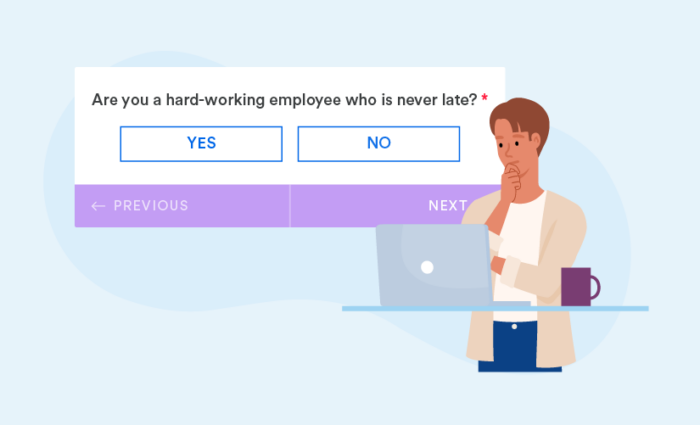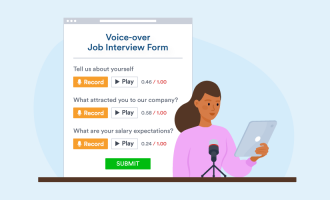If you’re not careful about how you phrase your questions, in surveys and beyond, you may end up with inaccurate results. While you’ve probably heard general advice about what to avoid, like leading and ambiguous questions, there’s one culprit that yields skewed results and can go overlooked: the double-barreled question.
When a double-barreled question strikes, respondents often hesitate, struggling to come up with a proper response. To understand why these questions can lead to confusing results and even more confused respondents, let’s tackle what they are first.
Pro Tip
Create online forms, surveys, and questionnaires — free of double-barreled questions. Explore Jotform’s 10,000+ free survey templates!
What is a double-barreled question, anyway?
A double-barreled question is an informal fallacy. When you ask two questions but allow for only one response, you have a double-barreled question, according to Qualtrics. (Here’s a quick example of one: How happy are you with your salary and benefits?)
A double-barreled question (which primarily appears in research studies, surveys, and courtrooms) is confusing for the respondent because it’s essentially two questions in one. This often makes them unsure how to respond — answer the first question, the second question, or neither? If you include a double-barreled question in a survey or questionnaire, like a customer feedback survey, your results will likely be inaccurate.
While a double-barreled question is sometimes used deliberately (say, in a courtroom to intentionally cause confusion on the witness stand), it’s more often asked entirely by accident — due to general carelessness or a lack of proofreading — and your respondents might answer incorrectly or skip it outright.
To decrease the chances of this happening, a good rule is to search for the grammatical conjunction “and” to pinpoint a double-barreled question. Of course, this isn’t a foolproof test, as the word “and” can appear in a properly formulated single question.
Double-barreled questions are just as frustrating in other situations, like court trials. They may be used to trick witnesses into admitting to something unintentionally. An example of a double-barreled question in a court would be something like the following: As you approached the intersection, did you look down, change the radio station, then look up, and for the first time notice the oncoming car?
The opposing attorney would object, of course, because it’s a double-barreled question.
Examples of double-barreled questions
Double-barreled questions are often the result of a lack of proofreading.
- Should the government spend more money on education and less money on military funding?
You could agree with both parts of the above sentence. Or you might think that the government should spend more money on education but disagree that it should spend less on military funding. If the latter is the case, by saying “yes,” you’re really only half in agreement. That would make the results inaccurate.
Instead, you could phrase this as two separate questions:
- Should the government spend more money on education?
- Do you believe the government should decrease military funding?
Here’s another example:
- How well do you get along with your manager and coworkers?
If you were only able to respond to this question on a scale of “not well” to “great,” it would mean you’d be forced to lump your feelings about your coworkers with your feelings toward your manager. That’s fine if you feel exactly the same about both, but odds are, you don’t. You can love your coworkers and hate your boss, or vice-versa.
A better way to ask this would be in the form of two questions:
- How well do you get along with your manager?
- How well do you get along with your coworkers?
Double-barreled questions are all too common with agree/disagree questions like the following example:
- Please agree or disagree with the following statement: The subway should be free and more reliable.
With only the options to agree or disagree, you’re left unable to expand on your response. If you’re a proponent for a more reliable subway but believe that riders should still pay a fare, then you won’t know how to respond. Again, asking the questions separately is the best route:
- Please agree or disagree with the following statement: The subway should be free.
- Please agree or disagree with the following statement: The subway should be more reliable.
Here’s a double-barreled question that doesn’t use “and” but still limits responses like the above examples:
- Are you a hard-working employee who is never late?
While this would be ideal if you’re looking for an employee who is both, it may skew responses if you’re trying to determine whether a hard-working employee goes hand in hand with never being late. Phrasing the questions separately will yield more accurate results:
- Are you a hard-working employee?
- Are you ever late for work?
Other types of questions to avoid
Double-barreled questions aren’t the only kinds of questions you should steer clear of as you compile survey and research study questions.
For the most accurate survey results, also avoid asking these kinds of questions.
Leading
Similar to double-barreled questions, leading questions include bias, opinion, or non-neutral language that can set a certain expectation for how respondents should answer or sway them in a specific direction. As a result, their responses may not reflect their true opinions or experiences.
Using our most recent double-barreled question as an example (How well do you get along with your manager and coworkers?), a leading question along those same lines would be: Your manager is one of our most valued, hardworking employees. How would you rate her dedication to your department?
More subtle leading questions can even include a simple adjective or two that favors one answer over another: “How would you rate your hardworking manager’s dedication to her department?”
Loaded
Loaded questions make an assumption about the respondent — which may or may not be true — and force them to provide a response about that assumption, which they may or may not agree with. Again, using our above manager/coworkers question, an example of a loaded question would be: Why don’t you get along with your manager and coworkers?
Loaded questions can also put respondents on the defensive, which can alter how they answer any remaining questions — once again skewing the results of your survey.
Biased
Though bias crops up most often in leading questions, it’s sometimes prevalent in the very beginning stages of survey creation — from who you include in the survey population to how you organize the questions.
Something as simple as disseminating a survey electronically can be an example of bias (after all, not everyone has 24-7 access to a phone or computer). So, before you draft or send out your survey, make sure that your survey population and the questions you’re asking line up with your survey’s overall purpose and goals.
Double-barreled questions are problematic in surveys — creating skewed data and inaccurate results that can affect how you make business decisions. But now that you have a better understanding of what they are, you’re better equipped to avoid using double-barreled questions in future surveys.




































Send Comment: